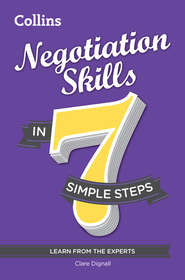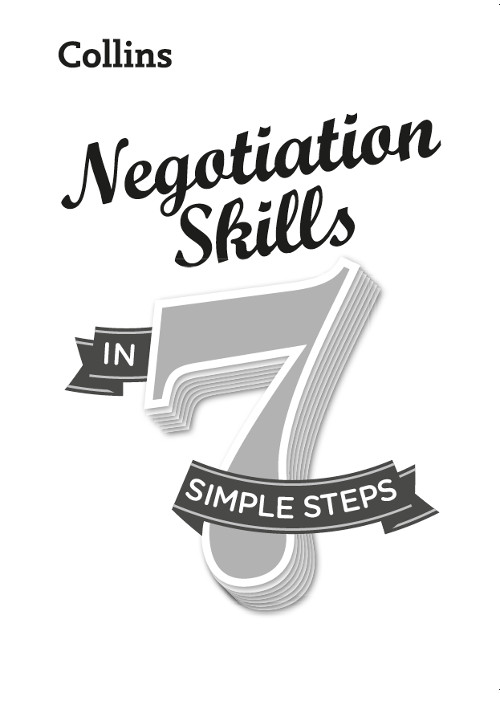
Полная версия:
Negotiation Skills in 7 simple steps


Contents
Cover
Title Page
Step 1 Understanding negotiation methods
Step 2 Prepare your strategy
Step 3 Take control in the early stages
Step 4 Propose, bargain and agree
Step 5 Find the win-win window
Step 6 Deal with difficult moments
Step 7 Close the deal
Keep Reading
About the Author
Copyright
About the Publisher
Step 1
UNDERSTANDING NEGOTIATION METHODS
‘No question is ever settled until it’s settled right.’ — Ella Wheeler Wilcox (1850–1919), Poet
Five ways to succeed
Negotiate to invest in relationships, not to damage them.
Recognize how frequently you negotiate in everyday life.
Always ensure there is enough time for negotiations.
Identify what you can concede to help reach agreement.
Learn as much as you can about your opposite number.
Five ways to fail
Take up a fixed negotiating position, and don’t give in.
Use the methods that have worked for you before.
Don’t waste time planning; spontaneity gets results.
Never build relationships before negotiations.
Don’t assign team roles; let everyone speak equally.
What is negotiation?
Hear the word ‘negotiation’ and you’ll probably imagine sharp-suited executives haggling across a gleaming boardroom table, or millionaire footballers hammering out transfer deals with big-name clubs. Whatever comes to mind, it’s unlikely that the images you come up with are of people just like you. Inexplicably, we associate the word ‘negotiation’ with people who are rich and powerful: that negotiating is something we’ll never have to do. But that’s just the thing; we negotiate all the time, every one of us, with varying success.
So, if it’s not just boardroom stuff, what is it? At its core, negotiation is nothing more than a dialogue between two or more parties working towards making an agreement, resolving a conflict, or reaching mutually beneficial goals. Sound familiar? In fact, you’ve probably negotiated a couple of times before lunch today already. In its most common guise, negotiation is the simple process of explaining your needs, exploring options and reaching agreement in ways that make life more navigable. At its most strategic, these basic tactics are formalized into standard procedures that can, for example, help businesses work together, help ambassadors improve international relations, and in the direst circumstances, save the lives of prisoners and hostages.
Why should we negotiate?
In an effort to appear easy-going, we may often avoid speaking out for the things that we want or need from life, whether that be in personal relationships or in our working lives. This means we’ll avoid negotiation, because it just doesn’t feel natural. Many of us assume that negotiating will jeopardize ongoing relationships with a loved one, or with an employer. But in many cases, this assumption is wrong, and avoiding negotiation means everyone loses: the partner in a relationship who never voices their needs may be taken for granted and decide to leave; the single parent who won’t ask for flexible working may end up quitting a good job for a dead-end one that better fits the school day. But by careful negotiation, such endings can be avoided. The key is identifying, and striving for, areas of mutual advantage that will allow everyone to benefit in some way (often called a win-win situation). If this happens, both relationships can emerge intact, or even improved. Negotiating needn’t necessarily entail conflict; there may be tough moments on the way to resolution, but by negotiating the problem side by side, you’re actually investing in the future relationship, rather than damaging it.
Different negotiation environments
Though we negotiate constantly in our daily lives, the prospect of negotiating at work can still be terrifying. If you’re feeling like this, it’s worthwhile looking closer at everyday negotiation environments and noting how they use repeated and recognizable processes. Acknowledging these skills you’ve developed ‘off-duty’ can help you build a portfolio of negotiation experience to apply in the workplace.
Resolving conflict
To successfully resolve disputes we create a setting in which each party can air their grievances objectively. Both sides must try not to let anger cloud the issues, because ‘getting personal’ just doesn’t help. Both may then explain the areas they find unreasonable. Exploring how the dispute has come about and developed is an important step in preventing recurrence. Having identified the problem, it’s time to propose solutions for mutual benefit. Facing conflict promptly is central to resolution. This may sound like a complex set of procedures, but it’s likely you’ve navigated them a thousand times, whether resolving an argument with your partner, or agreeing the line of a boundary fence with your neighbour. Next time you resolve conflict at home, note the actions you undertook, and consider how you might use them in the workplace.
Making decisions
A negotiated decision’s central premise is that you are trying to reach a decision that’s ‘better’ than would have been possible without negotiating. Say you have to agree with another team from your office on a new software package that you both need. To reach a decision, both sides must research options to understand the choice and availability, and agree the selection criteria they’ll use, so it’s clear the final choice will be a fair one. Then they need to identify constraints, as some packages may not have all the features each team needs. Both parties may need to make concessions – perhaps sacrificing a desirable software add-on to keep the purchase affordable for everyone. Sound complicated? You’re more experienced in this than you think. These are the exact processes we undertake to make the simplest decisions – where to eat, when to take a holiday, what colour to paint our living rooms.
Buying
Buying in the workplace can take many forms, from purchasing contractor services to hiring staff. The buyer must identify the needs of all interested parties, agree available budget and sche-dule, and research the options that meet the majority of these needs most effectively. At the point of purchase, and if the time is right, the buyer may even haggle, on price perhaps, or try to get an ‘added extra’ that sweetens the deal. It’s worth remembering that these procedures are the very same we undertake when making a big personal purchase, such as buying a house, a car, or a holiday.
Selling
Successful selling depends on how well we know our product and our market. Whether punting vintage comics on eBay, or leftover lawn turf to a colleague for cash; the vendor must know what their product or service provides in terms of benefits, and what competitors charge, before they can arrive at a fair price. How does this apply to negotiation? Take this skill-set and apply it, for example, to negotiating for better pay, which is, in blunt terms, ‘selling’ the product of you at market value, and not a penny below it.
Many skills needed for successful negotiation are ones that we apply in our daily lives, probably without noticing. By taking this tool kit, extending and formalizing it a little, we can approach negotiation in our working lives too. Whether you seek to advance your career or get a good deal from suppliers, believe it or not, you’re already surprisingly well-equipped.

Knowing when to negotiate
While developing your negotiation skills is invaluable, it’s just as important to know when it’s appropriate to negotiate and when it’s not a good idea. Recognizing when negotiation isn’t an option will save you time, effort, and credibility.
Do both (or more) parties have something to gain?
To negotiate, you and your opposite number must have some common ground to work from, and both must have something to gain.
Do you want to stick around?
Do you want to have a future relationship with the other party? If so, negotiation is the best option, because if you don’t share your needs, one or both of you will walk away.
Do you and the other party (or parties) have time?
If time is short, and you can’t postpone negotiation, you’ll be unable to prepare effectively enough to achieve much. You wouldn’t choose a holiday in 90 seconds, so it’s unlikely you’ll successfully negotiate better pay on finding yourself in the lift with your boss.
If you open negotiations while the other party is under pressure at work or home, you risk an abrupt response because they need to keep proceedings short.
First steps
Perhaps the most pivotal aspect of negotiation beyond all others is preparation. By preparing for every negotiation on an individual basis, you’ll boost your chances of reaching a satisfactory resolution, starting here:
Set a primary ‘gut feeling’ objective
Before you even start to research the market or set of circumstances in which you’re negotiating, write down what you would want to achieve in an ideal-world scenario. This will focus your research efforts and provide clarity for the road ahead. Look back at this objective any time that you feel your negotiation proceedings are getting lost in detail.
Make time to gather knowledge
Only by preparing properly will you be able to gather enough information about your opposite number, and the issue under discussion, to give your negotiations authority and credibility. In the next few pages we’ll look at preparatory research in depth.
Never assume what worked before will work again
If you’ve negotiated before, and with success, it’s forgivable to assume that you’ll do the same again by applying the same tactics. But, every negotiation is unique – even one new face or a different deadline in the mix can hugely alter the objectives.
Know what you want
Once you’ve identified your ideal objective, which can be as simple as ‘get myself a pay rise’, you should examine what it is you really want – in detail. Here are a few examples to get you started:
What do I/we want to get as a result of the negotiations?
What would the perfect deal be?
What would an acceptable deal be?
When do I/we want or need negotiations to start and finish?
What are my/our financial limits/aspirations?
How important is the ongoing relationship with the other party?
How long can I/we wait for delivery of the agreed item/terms?
Asking yourself or your team these questions will help you identify acceptable alternatives to the ‘perfect deal’, or note some aspects that you’d be willing to trade off. What is key in identifying what you want is not establishing a determined, immovable ‘position’, but what your specific interests really are. Knowing what these interests are will provide you with much more material to negotiate with than creating a fixed stance over which the only choice is to haggle aggressively. Noting these interests is also the first step in creating your negotiation strategy.
Know what you can give
After identifying what your specific interests are, ask yourself and/or your team some open questions to reveal just how little or how much you’re prepared to bargain. Everyone must agree on these terms wholeheartedly, and stick to them. Here are just a few examples of the type of questions you may ask:
Could I/we wait for a better sale price/a bigger payrise in the longer term?
Could I accept home working in place of a car allowance?
Could I accept more annual leave instead of a bonus this year?
But how can ‘giving in’ suit both parties? Surely you’re losing out? Not necessarily, because the analysis process can reveal some unexpected interests you didn’t know you had. You may, for example, realize that an immediate bonus rather than a later pay rise would suit you because you’re getting married and don’t want to take out a loan for the wedding. You’re happy: your employer is delighted. Analysing what you really want and what you’re willing to give are the first foundations of your negotiation strategy, and will provide you with materials that can be discussed and traded off to reach a resolution that potentially benefits both (or more) parties.
Know your USP
One part of your preparatory jigsaw still needs to be slotted into place. This is your USP, your ‘unique selling proposition’; the hook that will keep your opposite number interested in you and in reaching a good resolution, no matter how long the negotiation.
What is a USP?
The unique selling proposition is a marketing term which describes the qualities that only you can provide, or provide best, compared to all other competitors. The USP concept doesn’t just apply to negotiations related to buying and selling; ever-increasingly you’ll need to emphasize your USP in job interviews, and in negotiations for pay or promotion.
Recognize your USP
Whether negotiating as a team or one to one, you’ll have to know your USP. What can you offer that no one else can? What is it that makes you unique and sought after? Crucially, it must be an attribute that’s important to the other party, or your USP will be irrelevant. To identify your USP fully, you must consider it in terms of what your opposite party needs. When the time comes to research them, think carefully about what it is you could offer to respond uniquely to their requirements.
Get ready to sell your USP
Having a convincing selling proposition will help you counter most, if not all, challenges. For example, a proven ability to provide support across a number of office roles or, for suppliers, award-winning customer service will help counter statements such as ‘Liz has been here longer than you and isn’t asking for a raise’ or ‘we know another supplier who can undercut your costs’. When a USP offers an intangible but compelling concept of added value, it’s difficult for your opposite number to dismiss it, even against tangible factors such as price.
When you’ve determined your USP, it’s important that you’re comfortable talking about it, even before you begin negotiations. Take a little time to craft your USP into a short statement of no more than 20 clear, credible words. If you’re going into team negotiations, make sure every team member is comfortable with it, understands it, (believes it!) and can justify it if asked.

Know your opposite number
No matter what the circumstance, whether a neighbourhood campaign against a new road or negotiating for better working conditions in a factory, research will help you shape your negotiation strategy and help you make an educated guess about what the other party’s strategy will be too.
Gather all possible information
Ask the other party who they plan to field: Providing your opposite number knows you’re about to enter into negotiations with them, they should expect to be asked for such information. Ask who will be present, what their job titles are, and brief background information about them. Ask who’ll be leading, what roles the others will fulfil, and offer the same in return.
Search LinkedIn® and other social media: Now you’ve got names, explore their career profiles on LinkedIn® to discover their special interests and skills. Finding their profile page on Facebook or Twitter may uncover nuggets about likes and dislikes, hobbies and aspirations. This could give you common ground from which to build a relationship, or provide a talking point to ease a tense coffee break. And simply knowing what the other team looks like will help you fit names to faces quickly on the day, making you appear confident and attentive.
Check their company website: If you’re negotiating with representatives of a company, you should check the company website for information such as claimed service standards and company ethos. Being able to point out a mismatch between what they say during negotiations and what they claim on their site may give you some leverage.
Read their publications: Most company websites will hold newsletters, annual reports, and staff magazines in pdf form. Annual reports provide financial information that can reveal, for example, any debts, expansion plans, and the company’s financial targets for the year. If you know they’re in debt, for example, this could put you into the driving seat of negotiations, as you know they’ll be keen to work quickly to save money. If, on the other hand, you’re being interviewed for a job and plan to negotiate your starting salary upwards, then quoting their staff magazine on how crucial recruitment is to the health of the company may also make them sit up and take notice.
Talk to their customers: Whether a big corporate or a one-man band, most companies are proud to list important clients on their website. Do you know anyone listed there? Can they tell you about their experiences of working with the person or company you’re interested in? Take some time to catch up with these contacts. If it feels appropriate, they might be willing to provide insights into their own negotiations with the company you’re dealing with, or mention any customer service shortfalls they’ve experienced.
Profile the people: Whether it’s one person or a whole team, you now have an idea of their career path, likes, dislikes, common contacts, and any shared interests. By digesting their LinkedIn® profile (especially their recommendations) you may also build up a picture of their workplace strengths and style. Facebook and others may reveal glimpses of temperament and person-ality. It’s good to know in advance if you’re coming to table with a tough negotiator, and equally useful to know if your opposite number is inexperienced, which can make for both easy, or unpredictable, negotiations.
Profile the company: Look for common company objectives that could provide potential for joint gains. Perhaps they aspire to becoming more ‘green’ and your cleaning service uses eco-detergents and recycling as standard? Perhaps they plan to gain more local clients to cut back on travel costs, and you’re slap bang in their neighbourhood. What are their published service standards compared to what customers tell you? Explaining that you’re aware of a shortfall could give you valuable negotiation leverage.
Get to know each other
Establishing a preliminary relationship before negotiating may instil a glimmer of mutual trust. Email to arrange negotiations dates, venues and teams. Vary your contact – if they’re coming to you, email to confirm arrangements, then make a friendly call later to check if they’ve additional needs on the day, like a flipchart or veggie sandwiches. Keeping contact regular and approachable makes the prospect of meeting at the negotiation table much less daunting.
Know your team
While many of your negotiating experiences will be one to one, there may be times when you feel it’s better to bring helpers to the table with you. But when?
When is it best to use a team?
To represent the interests of many: Where the welfare of many is at stake, e.g. in neighbourhoods, local councils, retail, construction, call-centres and factories, a team of individuals who each represent a constituent group can better reflect their diverse needs.
When you need to think differently: Where negotiations are complex, where there seems no way of reaching a mutually beneficial result, or if a one-to-one negotiation has already broken down, it’s time to bring in the collective imagination of a team.
To show that this is important: Turning up in number is a concise way of saying this is important to you. For example, a team would underline the depth of community feeling if fielded against a construction company surveying parkland. However, turning up mob-handed on your neighbour’s doorstep to discuss his hedge, or arriving to talk pay with your boss flanked by colleagues, will look aggressive. If it’s important only to you, then it’s usual that only you should turn up.
How to choose your team
If you plan to field a team in negotiations, it’s crucial that your own people don’t throw you any curve balls – there will be enough surprises coming from your opposite party. Consider the following steps when selecting your negotiating team.
1 Choose members wisely: If you’re negotiating in a particular field, you may want a specialist in that topic on your team to advise. If you have to talk money and pricing, you’ll want someone who’s good – and fast – with numbers. If possible, don’t include anyone, no matter how close you are, who you suspect may be a weak link. If they’re being pressed upon you by your boss, ensure that person understands that, during the negotiation, it’s the lead negotiator who’s in charge, not the boss.



